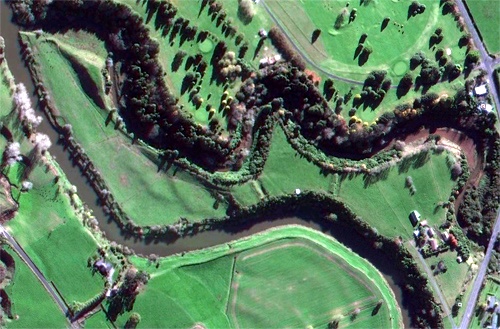
Mātakitaki pā (1822)
Our bloodiest killing field?
The musket entered intertribal warfare in 1807 as Ngāpuhi traded food, timber and sex for guns. Many early guns were notoriously inaccurate but their surprise value demoralised opponents unfamiliar with them. Sustained by another European import, the potato, war parties of 1200-3000 spread south in a domino effect, led by men such as Bay of Islands chief Hongi Hika. Hongi needed few reasons for manufacturing grievances, but Waikato had angered him by sheltering Ngāti Whātua and Ngāti Pāoa refugees from Tāmaki. In February 1822 3000 Ngāpuhi paddled from Kerikeri to Tāmaki, portaged to the Manukau, paddled across to Waiuku, portaged a second time and launched their canoes into the Awaroa, a tributary of the lower Waikato. Fleeing Waikato blocked the Awaroa with trees to buy time while the rest prepared to make a stand at Mātakitaki.
Mātakitaki pā was built on a narrow strip of land at the junction of the Waipā River and the Mangapiko Stream. The name Mātakitaki covers three sections, Mātakitaki to the north-west, Taura-Kohia, and Puketutu to the east. The waterways and riverbanks provided the main defences, which Waikato supplemented with the usual ditches and palisades. Perhaps 5000 to 10,000 took refuge here – Musket Wars numbers are notoriously debatable, though the smaller figure, probably the more likely, was still a very big number for a country of then only about 100,000 people.
First blood went to the defenders when Te Wherowhero and a small detachment surprised some Ngāpuhi, killing perhaps 150 and capturing 90 muskets. Illustrating the cliché that pride comes before a fall, jubilant Waikato leaped up onto the parapets to shout defiance and insults, only to tumble back, felled by Ngāpuhi musketry. Panic deepened when Te Wherowhero’s men fired their captured guns, spooking their own men into thinking that Ngāpuhi had breached the defences. Hundreds of terrified Waikato were smothered in the ditch while trying to flee. Te Wherowhero and his men resisted for as long as they could, but had to retreat to Manguika, 8 km away. Next day they rolled Ngāpuhi back to Mātakitaki before withdrawing. It was an expensive lesson for Waikato. They lost perhaps 1500 and hundreds more were taken prisoner.
Further information
This site is item number 11 on the History of New Zealand in 100 Places list.
On the ground
There is an old Historic Places Trust concrete marker on the site.
Websites
- Musket Wars – Te Ara
- Musket Wars – NZ History
- Journal of the Polynesian Society article
- Hongi Hika biography – Te Ara
Book
- Matthew Wright, Guns and utu: a short history of the Musket Wars, Penguin, Auckland, 2001
Article
- Hugh Barr, ‘Matakitaki pa: muskets reach the Waikato’, Historic Places in New Zealand, no. 22, 1988, pp. 3-5


Community contributions